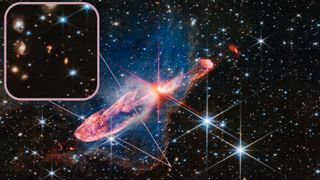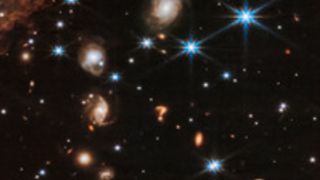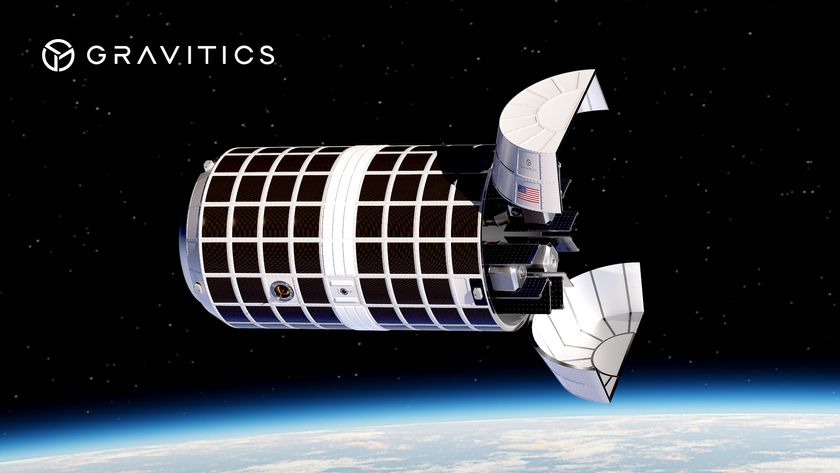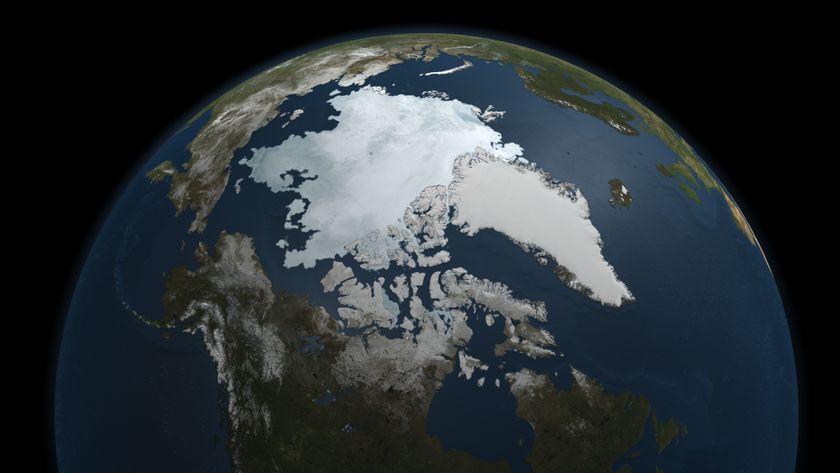James Webb Space Telescope spies giant cosmic question mark in deep space (photo)
When looking for answers in the cosmos, sometimes more questions appear.

The James Webb Space Telescope continues to provide answers about the earliest days of the universe, but it's also discovering more questions.
Question marks, to be precise. The James Webb Space Telescope (JWST) team at the European Space Agency (ESA) released an image on Wednesday (June 26) offering the most detailed look yet at two actively forming young stars located 1,470 light-years from Earth in the Vela Constellation. In the image, the stars, named Herbig-Haro 46/47, are surrounded by a disk of material that "feeds" the stars as they grow for millions of years.
But just below those stars, in the background of the stunning deep-space image, is an object resembling a giant cosmic question mark. Is the universe asking us something?
Related: James Webb Space Telescope stuns with glowing portrait of actively forming stars (photo)
It's unclear exactly what the question mark-shaped object might be, but its color and shape give us some idea.
"It is probably a distant galaxy, or potentially interacting galaxies (their interactions may have caused the distorted question mark-shape)," representatives of the Space Telescope Science Institute (STScI) in Baltimore, which manages JWST's science operations, told Space.com.
According to STScI, the object's red color in the JWST image tells scientists that the object, whatever it may be, is quite distant. Even more exciting, this might be the first time astronomers have seen the cosmic question mark.
Get the Space.com Newsletter
Breaking space news, the latest updates on rocket launches, skywatching events and more!
"This may be the first time we've seen this particular object," STScI added. "Additional follow-up would be required to figure out what it is with any certainty. Webb is showing us many new, distant galaxies — so there's a lot of new science to be done!"

Matt Caplan, an assistant professor of physics at Illinois State University, told Space.com that the object might be two galaxies merging. "The two distinct features could easily be merging galaxies in the background, with the upper part of the question mark being part of a larger galaxy getting tidally disrupted," Caplan said. "Given the color of some of the other background galaxies, this doesn't seem like the worst explanation. Despite how chaotic mergers are, double lobed objects with curvy tails extending away from them are very typical."
Caplan added that there are plenty of other possibilities, as well, but rules out a star due to the lack of the eight-pronged refraction spikes that appear to emanate outward from stars in JWST's images as a result of its mirrors.
More stunning discoveries such as this cosmic question mark are sure to come thanks to JWST's high-resolution near-infrared imaging capabilities, which allow it to peer into the far reaches of the universe, spotting galaxies as distant as 13.4 million light-years away that existed just 420 million years after the Big Bang.
Over 750 pieces of peer-reviewed scientific literature using data produced by the James Webb Space Telescope have been published in its first year of operations, according to STScI.
Join our Space Forums to keep talking space on the latest missions, night sky and more! And if you have a news tip, correction or comment, let us know at: community@space.com.

Brett is curious about emerging aerospace technologies, alternative launch concepts, military space developments and uncrewed aircraft systems. Brett's work has appeared on Scientific American, The War Zone, Popular Science, the History Channel, Science Discovery and more. Brett has English degrees from Clemson University and the University of North Carolina at Charlotte. In his free time, Brett enjoys skywatching throughout the dark skies of the Appalachian mountains.









